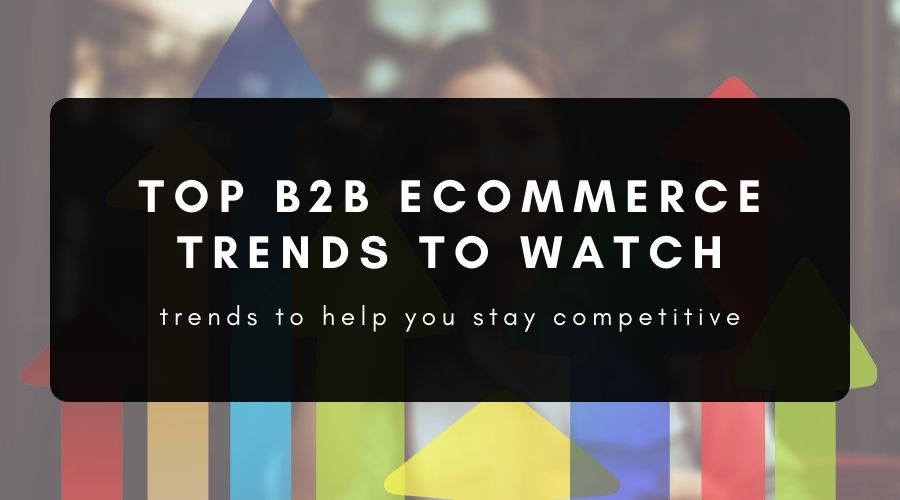
B2B E-Commerce Trends That Can Boost Your Business
B2B e-commerce has been around for around 30 years, but the trends associated with digital commerce for B2B have been accelerated and transformed by the global pandemic. Now, in 2022, these B2B e-commerce trends are disrupting the industry in the post-pandemic world.
Where to Start
B2B businesses have taken longer to adopt digital strategies than their B2C counterparts, largely due to the complex sales cycles involved with a B2B business model and the relationship-based nature of wholesale contracts. However, with Millennials emerging as the next generation of business owners and the pandemic pushing work online, using online sales channels is no longer a luxury—it’s a necessity.
According to a report from Wunderman Thomson, 49% of businesses in the UK, US and China purchased their B2B supplies online in 2021. And according to McKinsey & Company, around 65% of B2B companies conduct business completely online as of 2022. Concerningly, 52% of B2B buyers surveyed found the online buying experience frustrating and 90% would go to a competitor if their B2B seller’s online platform didn’t meet their needs.
Adopting the following trends immediately will put you in a good position to catch the wave:
Start with Your Existing Customers
B2B businesses that are moving online effectively are beginning with their current customers rather than seeking new customers at the start. While this may seem counterintuitive, starting with your existing customers is a good idea for several reasons:
- Starting with your existing audience ensures sales from the outset, increasing your confidence that going digital is worthwhile.
- Offering digital sales to your current list can help you retain existing customers instead of losing them to your competition.
- Selling online to your current customers provides more meaningful data than offline sales to the same audience. This data will help you to analyse whether a trend you’re trying is working well.
Start with One Department or Product Line
Just as starting with your current customers is more doable than reaching out to the entire world, it’s also a good idea to start with one department, product, or collection rather than upload your entire inventory at once. Taking your business online in one hit can be daunting and, in many ways, riskier than perfecting your digital channels before scaling to offer everything online.
Use an ERP-Integrated Solution from the Get-Go
As stated earlier, B2B sales are more complex than B2C sales, which is why integrating your e-commerce platforms from the start is essential. Whether you create your own separate e-commerce site or offer your products through an online marketplace like Amazon Business, you’ll need a way to integrate your e-commerce platforms with inventory updates and take care of data management in a single place.
Several e-commerce technology solutions exist to help B2B websites integrate their sales channels and deliver a streamlined customer experience, including e-commerce platforms that are built around integration as well as third-party ERP (enterprise resource planning) solutions. Integrated e-commerce platforms will—in most cases—mean lower total overheads and less work keeping everything synchronised.
Integrate B2B E-Commerce Trends with Traditional Offline Strategies
The fear of many B2B businesses is that having an online sales channel will replace their sales team and make traditional sales channels redundant. However, the reality is that the two go hand in hand. Trade shows, conferences, and product trials are still an important way to meet potential customers and educate business owners about the value of your products. After making the initial contact, new contacts can make purchases through your digital channels, freeing up your sales representatives to continue to grow your customer base.
Integrating online and offline strategies also applies when it comes to quotes. Traditionally, potential customers would call suppliers to ask for quotes over the phone. With an e-commerce platform, potential customers can submit all of the relevant information in a form and your sales rep can call or email them with a quote in minutes. The result is that your sales reps can deliver an accurate quote sooner than they could otherwise, improving your chances of securing the deal.
Basic Customer Expectations
Whichever kind of online platform you choose, it must meet customer expectations and take modern customer behaviour into account if your business wants to remain competitive. These basic customer expectations are a must as B2B e-commerce trends today go and will help to increase customer loyalty to your brand:
Payment Options
To make B2B sales online, customers need secure and convenient digital payment options. This means investing in a global payment gateway and merchant services that provide you with detailed sales reports and analytics and collect customer data on your behalf. A well-equipped merchant service provider, like Unicorn Group, will allow you to offer traditional payment options like credit and debit cards, electronic funds transfers (EFTs) and cheques as well as emerging trends in payment technology like recurring billing and digital wallets.
Optimise for Mobile
Only a tiny fraction of B2B sales are currently made on mobile devices, although the number of sales on mobile is growing. While desktop and laptop sales still predominate, it’s important to optimise your website for mobile devices to make sure you’re not losing out on potential sales. If you use an e-commerce platform like Shopify or BigCommerce, optimising for mobile is usually automatic. Simply switch to mobile view to check that everything displays as it should.
Customer Personalisation
Business customers don’t have a lot of time to browse through catalogues of products that aren’t relevant to their business. You can help them solve this problem with an AI-driven personalised front-end customer experience. Research from Accenture shows that business customers spend 48% when their buying experience is personalised, making AI-driven suggestions an important tool for bringing customers in at the start and increasing revenue with post-purchase cross-sells and up-sells.
Product Information
You know that your products are wonderful, but potential buyers don’t. That’s why it’s essential to focus your digital marketing efforts on customer education. Content marketing is based on the idea of connecting with your potential customers through keyword-rich written content that educates them about the very topic or product they’re already searching for. This content typically takes the form of blog posts, written content on the home page, category pages and individual product pages.
Digital Marketing Ideas that are Essential for B2B
Taking inspiration from current B2B e-commerce trends, you’ll want to include case studies about how your products have helped other businesses in the past. You should also consider investing in video marketing with informational videos demonstrating how your products work and explaining their unique features. If you do digital marketing right, your sales reps will be able to focus on buyers who are already at an advanced stage of the buying process when they call.
Real-Time Inventory Availability and Expected Delivery Dates
In the rush to hop on the digital bandwagon, many B2B businesses have created websites that showcase their products. However, failing to keep these websites up-to-date with stock levels and delivery dates leaves buyers frustrated and sends them to your competitors instead. Using a software integration solution, ensure that your B2B web store displays information about inventory availability and estimated delivery dates that are automatically updated in real-time.
Delivery Dates Are Never Static
As business owners will know from experience, delivery dates are never static and can be affected by a whole host of factors, including traffic conditions, natural disasters and border closures. That’s why new software solutions calculate (and update) the estimated delivery date in real-time, taking supply chain factors into account.
Personalised Quotes
Once a customer is interested in a product, they need to know how much that product will cost and whether you can offer them a special deal. As B2B pricing is personalised and not fixed, your B2B e-commerce store needs the capability to offer dynamic pricing and personalised quotes automatically. Your store also needs to offer self-service repeat ordering using the prices you agreed on with the customer. Customer logins and unique discount codes are two ways to offer personalised pricing.
Comprehensive Post-Purchase Care
Once the sales funnel is complete, your e-commerce store needs to provide comprehensive post-purchase care. As far as B2B e-commerce trends go, this post-purchase care should include (at a minimum):
- Automated invoicing and payment receipts
- Automated emails with parcel tracking information
- Automated personalised emails to check that the goods arrived
- Automated reminders for repurchase
- Automated marketing emails with relevant cross-sells and offers
- Automated requests for feedback about the purchase
As you can see, the standard post-purchase steps can be automated for significant cost savings and error elimination. However, you still need to have live customer service representatives available to resolve any issues, respond to compliments, suggestions and complaints and handle more complex enquiries.
Ease of Doing Business
In short, business customers today want a buying experience that’s quick, easy, personalised, and streamlined with your back-end operations. If at all possible, business owners from the Millennial generation prefer not to pick up a phone unless it’s absolutely necessary. But if something goes wrong, they need you to be there to resolve the issue straight away.
Nice-to-Haves (but Not Essential)
So far, this article has covered the basic B2B e-commerce trends that you will need to implement to stay competitive in the new online market. However, once you’ve mastered the basics, consider these emerging trends—very soon, they’ll be considered essentials!
Self-Service Buying Portals
Just like self-service checkouts at the grocery store, business customers appreciate a self-service buying platform that puts them firmly in control of the buying process from beginning to end. Using predictive analytics, B2B businesses are now creating personalised offers and product suggestions automatically so that buyers can complete the entire process without needing to call.
As a starting point for self-service tools, consider using a chatbox plugin to respond to common questions quickly and automatically. Please note that chatbots need to be monitored by real humans during business hours to make sure that there’s no delay if a customer has a need or question that’s too complex for the chatbot to resolve.
Social Media Platforms
Social media marketing helps you expand and connect with your customer base with regular updates that are displayed to the most relevant audience. While you don’t have to be on all of the social media platforms at once (and trying to do so is usually counterproductive), it’s a good idea to post on the two or three that your target audience is most likely to use.
While some B2B businesses sell their products directly through social media, it’s sufficient for most businesses to use social media as a tool that directs customers back to their website with a call-to-action and click button that’s prominently displayed.
Stay Abreast of the Trends and Enjoy the Rewards
The B2B e-commerce trends described in this article might have once seemed like a pipe dream or an optional way to increase sales. The reality is that business owners today spend most of their time in the online space and that’s where they expect to find and purchase supplies. Using technology and marketing tactics that create a seamless, easy experience and increase customer satisfaction are the best ways to boost your e-commerce sales and revenue

